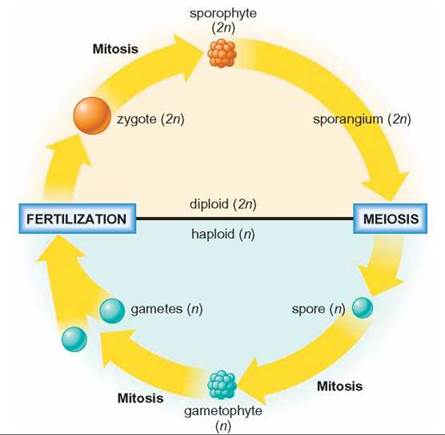CONCEPTS IN BIOLOGY
PART V. THE ORIGIN AND CLASSIFICATION OF LIFE
22. The Plants Kingdom
22.2. Alternation of Generations
Plants have a life cycle that involves two distinctly different generations: the sporophyte generation and the gametophyte generation. The sporophyte generation is diploid (2n) and has plant parts in which meiosis takes place to produce haploid (n) spores. The word spore is used several different ways. There are structures called spores in bacteria, algae, protozoa, fungi, and plants. Each is distinct from the others. In our discussion of plants, the word spore refers to a haploid cell produced by meiosis that germinates to give rise to a multicellular haploid generation known as the gametophyte generation. The gametophyte generation is haploid and develops structures that produce gametes: eggs and sperm. Because the gametophyte is already haploid, eggs and sperm are produced by mitosis. When haploid gametes unite, a diploid zygote is formed. The zygote is the first cell in a new sporophyte generation. The zygote divides by mitosis, and a new multicellular sporophyte generation results. Recall that the term alternation of generations is used to describe this kind of life cycle, in which plants cycle between two stages in their life—the diploid sporophyte and the haploid gametophyte (figure 22.2).

FIGURE 22.2. Alternation of Generations
Plants go through two distinctly different generations during their life cycle. The sporophyte generation is diploid and the gametophyte generation is haploid.
22.2. CONCEPT REVIEW
2. Which generation in the plant life cycle is haploid and which is diploid?
3. What reproductive cells do sporophytes produce? Are these structures haploid or diploid?
4. What reproductive cells do gametophytes produce? Are these structures haploid or diploid?